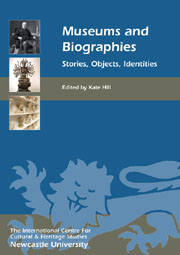Book contents
- Frontmatter
- Contents
- List of Illustrations
- Introduction: Museums and Biographies – Telling Stories about People, Things and Relationships
- INDIVIDUAL BIOGRAPHY AND MUSEUM HISTORY
- PROBLEMATISING INDIVIDUALS' BIOGRAPHIES
- INSTITUTIONAL BIOGRAPHIES
- OBJECT BIOGRAPHIES
- 12 Classifying China: Shifting Interpretations of Buddhist Bronzes in Liverpool Museum, 1867–1997
- 13 ‘Dressed like an Amazon’: The Transatlantic Trajectory of a Red Feather Coat
- 14 Individual, Collective and Institutional Biographies: The Beasley Collection of Pacific Artefacts
- 15 Sculptural Biographies in an Anthropological Collection: Mrs Milward's Indian ‘Types’
- MUSEUMS AS BIOGRAPHY
- MUSEUMS AS AUTOBIOGRAPHY
- Endpiece: The Homunculus and the Pantograph, or Narcissus at the Met
- List of Contributors
- Index
12 - Classifying China: Shifting Interpretations of Buddhist Bronzes in Liverpool Museum, 1867–1997
from OBJECT BIOGRAPHIES
Published online by Cambridge University Press: 05 February 2013
- Frontmatter
- Contents
- List of Illustrations
- Introduction: Museums and Biographies – Telling Stories about People, Things and Relationships
- INDIVIDUAL BIOGRAPHY AND MUSEUM HISTORY
- PROBLEMATISING INDIVIDUALS' BIOGRAPHIES
- INSTITUTIONAL BIOGRAPHIES
- OBJECT BIOGRAPHIES
- 12 Classifying China: Shifting Interpretations of Buddhist Bronzes in Liverpool Museum, 1867–1997
- 13 ‘Dressed like an Amazon’: The Transatlantic Trajectory of a Red Feather Coat
- 14 Individual, Collective and Institutional Biographies: The Beasley Collection of Pacific Artefacts
- 15 Sculptural Biographies in an Anthropological Collection: Mrs Milward's Indian ‘Types’
- MUSEUMS AS BIOGRAPHY
- MUSEUMS AS AUTOBIOGRAPHY
- Endpiece: The Homunculus and the Pantograph, or Narcissus at the Met
- List of Contributors
- Index
Summary
INTRODUCTION: THE LIVES OF OBJECTS
This chapter examines the lives of a set of five Chinese Buddhist deity figures in Liverpool Museum, from 1867 to 1997. The largest figure, an almost-life-size bronze statue of the Goddess of Compassion, Guanyin (see Fig 12.1), probably dates from the early 15th century. The other four – Wenshu, Puxian, Weituo and Guangong – are early 17th-century creations. All five belonged to a temple on Putuo Island, off the east coast of China. For over a thousand years this was one of the most important Buddhist pilgrimage sites in the country, devoted to the worship of Guanyin. The statues were taken from their temple in the 1840s by a British soldier just after the First Opium War (1839–42). Once transported to England, they appeared at the Great Exhibition in 1851 and the Manchester Art Treasures Exhibition of 1857, and were auctioned at Sotheby's two years later. After passing through the hands of antiquarian collectors, the Chinese statues were accessioned into Liverpool Museum in 1867, where they remain to this day (Tythacott 2009, 90–97).
This chapter draws upon igor Kopytoff's essay, ‘The cultural biography of things: commoditization as process’ (1986), in order to examine the biographies of these figures at Liverpool Museum. Kopytoff was the first to suggest that objects, like people, have ‘social lives’. Just as we may analyse the biography of a person, he argued, so too it is possible to examine the lives of objects and ask of them similar questions:
What, sociologically, are the biographical possibilities inherent in its ‘status’ and in the period and culture, and how are these possibilities realized? Where does the thing come from and who made it? What has been its career so far, and what do people consider to be an ideal career for such things? What are the recognised ‘ages’ or periods in the thing’s ‘life’, and what are the cultural markers for them? How does the thing’s use change with its age, and what happens to it when it reaches the end of its usefulness? (Kopytoff 1986, 66–7)
- Type
- Chapter
- Information
- Museums and BiographiesStories, Objects, Identities, pp. 173 - 186Publisher: Boydell & BrewerPrint publication year: 2012



